| . |
 |
Headquartered in San
Francisco, Calif., OQO(tm) Corporation
is the developer of the OQO
Ultra-Personal Computer, a full-power, full-feature Windows XP PC that
can be carried in the pocket as easily as a cellular phone. In 1999,
Jory Bell, Jonathan Betts-Lacroix and other members of the team that
developed the Apple Titanium powerbook, set out to construct a Windows
PC that you could carry wherever you go.
In 2002, OQO introduced the first
implementation of its Ultra-Personal Computer, refining the PC form
factor to its lightest and most versatile; creating a powerful modular
Windows XP PC that fits in one hand and also provides high-speed
wireless access. The first product will be available in the second half
of 2002. |
 |
IBM researchers Ken
Ocheltree and Bob Olyha inspect their "Meta
Pad" computer core invention -- a 3-by-5 inch, 9-ounce prototype
device that can transform in seconds into a handheld (shown), desktop
(shown), laptop, tablet or wearable computer. To make Meta Pad so small,
IBM researchers pulled the power supply, display and I/O connectors out
of the core -- leaving processor, memory, data and applications.
Components removed from the machine become accessories, and individual
users decide how they want to use the device.
|
 |
From a Yahoo Story
A full-size fully
functional virtual keyboard that can be projected and touched on any
surface is shown by Siemens Procurement Logistics Services at the CeBIT
fair in Hanover, northern Germany, on Monday, March 18, 2002. The
virtual interface from Developer VKB Inc. from Jerusalem in Israel can
be integrated in mobile phones, laptops, tablet PCs, or clean, sterile
and medical environments and could be a revolution for the data entry of
any mini computer. The mini projector that detects user interaction with
the surface also simulates a mousepad. The biggest computer fair of the
world is open for public until Wednesday, March 20, 2002. (AP
Photo/Martin Meissner) |
 |
Sony Japan has introduced two new innovative clamshell design Palm
OS handhelds. The
PEG-NR70 and
PEG-NR70V both have built-in keyboards and 320 by 480 color screens
with a virtual Graffiti area.
They also have a built-in keyboard, and MP3 and ATRAC3 audio players. The
PEG-NR70V also has a built-in camera.
These are the first
Palm OS devices to use the 66 MHz Dragonball SuperVZ processor from
Motorola. They have 16 MB of RAM and 10 MB of Flash ROM, and a 16-bit
color backlit TFT screen. They measure 5.4 by 2.8 by .65 inches and
weight 7 ounces. |
 |
VeloTrend BikeBrain is a new
class of bicycle computer that incorporates graphical displays,
route directions, dynamic
logging and smart features such as automatic wheel size calibration into
a multi-use, hand-held and handlebar mounted computer. It is designed
for use with Palm and
Handspring Visor personal
organizers. |
 |
GARMIN International is proud to introduce its first two GPS-enabled
handheld devices for the Family Radio Service (FRS) and high-performance
General Mobile Radio Service (GMRS) markets – the
Rino 110
and
Rino 120. These GPS devices integrate radio
functionality to provide two-way communications up to two miles using
FRS channels and up to five miles using GMRS channels.
Inspired by the
distinctive offset FRS and GPS antennas that give the devices their
Rhinoceros-like appearance, GARMIN designed the Rino series as powerful,
robust Radios
Integrated with Navigation for the Outdoors.
They are also the only waterproof two-way radios on the market.
What really
separates the Rino from the rest of the FRS herd is the ability to
"beam" your exact location to another Rino user within a two-mile range
using the FRS spectrum. This important feature is called
Peer-to-Peer Positioning (see box at right for additional
information). |
 |
Compaq is leading the evolution of customer needs from
simply computing to communicating - anytime, anywhere - with access
devices designed to integrate seamlessly into both work and home life.
With the iPAQ product line and now with Evo,
Compaq is 'visioneering'
into a new era of refreshed, energized and aggressive innovation. In
addition to the access devices included in the Evo family, Compaq is
also demonstrating its commitment to
visioneering with the showcasing of 'concept' products. These
revolutionary hybrid devices, developed in close collaboration with
Compaq customers, represent possible future generations of Compaq access
devices. At Compaq, we're devoted to the evolution of computing and will
continue addressing customer needs through the convergence of in-demand
customer services and solutions, and cutting-edge product design.
A notebook and desktop in one
This modular mobile product that integrates the dual
worlds of mobile and desktop computing transforms from a notebook PC
into a desk-based unit consisting of a flat panel screen and wireless
keyboard and mouse. This product would eliminate the need to have a
desktop PC and monitor in addition to a notebook PC.
For information on what happened to Compaq
|
 |
Inviso eShades
Inviso’s
eShades are a breakthrough personal display device that gives you
a big-screen viewing experience virtually anywhere. Simply plug
eShades into a laptop, and enjoy the view. |
 |
The
RSC WebPAD™ is a portable Internet access device for home or
commercial applications. The system consists of three pieces: The RSC
WebPAD™ (tablet), a cradle and a base station.
The
RSC WebPAD™ will bring to the market an inexpensive and easy way to
wirelessly access the Internet.
While
the primary feature of the RSC WebPAD™ system is Internet access and
Email functionality, other applications can be easily added to provide
for example remote PC capability.
|
 |
At
CeBIT 2000 in Hannover, Ericsson presented a new platform for the
Communicator product category the first step in the creation of a new
generation of integrated mobile devices. This unique combination of
mobile Internet browsing, messaging, imaging, location based
applications, mobile telephony and personal information management
constitutes the platform on which Ericsson intends to build future
commercial products.
Ultimately addressing the needs of the 3G cellular networks, the
communicator platform is prepared for the latest in GSM technologies.
It supports Internet access via both WAP and HTML. With the built-in
Bluetooth-chip, it can connect wirelessly with other devices.
Symbian’s open platform (EPOC) allows for personalisation with third
party applications. With the built-in GPS receiver, the device is
ideal for applications providing positioning information. The user
interface is based upon the ¼ VGA format which Ericsson firmly
believes to be an ideal size for mobile communication devices and
applications. A colour touch screen allows for easy navigation,
pen-input and handwriting recognition. |
 |
xpressa™
- the world's first Java VoIP phone.
It's the
end of the dumb phone forever and the beginning of:
the
intelligent phone,
the powerful phone,
the fun phone,
the elegant phone,
the personalized phone.
It's the phone
for the Internet age. |

|
A
Taiwanese company called Saint Song Corporation has built a one-pound
PC about the size of a postcard. The Espresso supports
"flip-chip" Celerons and Pentium IIIs, has the usual array
of ports -- including VGA, keyboard, mouse, and USB -- and is based on
the Intel 810 chipset. There's an integrated touchpad, and room for an
industry-standard 2.5-inch hard drive. A separate docking station
carries a floppy and CD-ROM drive, plus standard serial and parallel
ports. With the addition of a keyboard and monitor, it seems to be a
true-to-life, fully functional PC.
This is just a
little big to stow in a pocket, and its power requirements and absence
of a screen and keyboard make it impractical for mobile use. But maybe
with one of those Borg-like Reflection Technologies eyepiece monitors
or a Sony Glasstron, and some hacked keyboard kind of thing...
With a 700MHz
PIII, it costs $1,299 at Ibuypower.com.
With a 533MHz Celeron, it's $899. |
 |
Samsung
is working on a new pocket organizer called the Multimedia PDA. Unlike
most handhelds, this one doesn't run on the PalmOS or even Windows CE.
It may be the first-ever pocket computer to run on Linux.
The Samsung Multimedia PDA has an impressive set of features,
including built-in MP3 player, web browser and e-mail applications.
The device has a nearly four-inch tall truecolor display (65,536
colors) with a backlight. Like some Windows CE Palmsize PCs, it also
has a CompactFlash slot and plays color videos. It even picks up radio
broadcasts.
The only thing wrong with the Multimedia PDA is that it doesn't
exist...yet. At this point, it's just a prototype.
Samsung hasn't yet announced a ship date, price or where they'll sell
it. I'll share those details with you as soon as they become
available. |
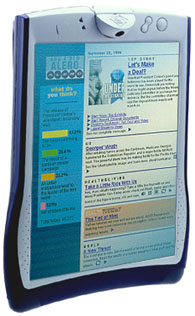 |
The Qbe incorporates the speed
and functionality of a desktop computer with the true mobility of a hand-held device. By
integrating the latest in microprocessors, handwriting and speech recognition, a digital
video camera and wireless connectivity, and many other peripherals, the Qbe is in a class
of its own. Qbe can contains a Pentium
II or III processor, up to 512MB of RAM and a 9GB hard drive along with a 13.3-inch
screen. The tablet features a touch screen and handwriting recognition software, together
with an integrated color digital camera, which can capture video or still images.
A docking station, called
the Qbicle, is also available for the device. |
 |
Hewlett-Packard
Co. is first among what are sure to be many storage vendors unleashing
rewritable DVD drives. HP's entry, the DVD Writer 3100i, reads DVD-ROM
discs, can hold up to 100 minutes of video. It can also read DVD
movie, CD-RW, CD-Recordable (CD-R), CD-ROM and CD audio discs.
The DVD Writer 3100i is an internal SCSI drive that
reads and writes DVD+RW media at a speed of 1.25X or 1.7MBps,
approximately equivalent to 11X CD-RW write speed. The HP DVD Writer
3100i is expected to begin shipping worldwide this fall (1999) with an
estimated street price of $699; DVD-RW discs are expected to cost
around $30 each. For more information, call 650 857-1501 or www.hpdvd.com. |
 |
Combination CD-RW / DVD-ROM
Drive: As a leader in optical storage products Toshiba leverages its
technology expertise to deliver the SD-R1002. The world's first
combination CD-RW drive with DVD-ROM readability to hit the market.
The drive features a fast writing speed of 4X for CD-R and CD-RW, and
employs a full 24X speed maximum playback for CD-ROM and 4X for DVD-ROM. |
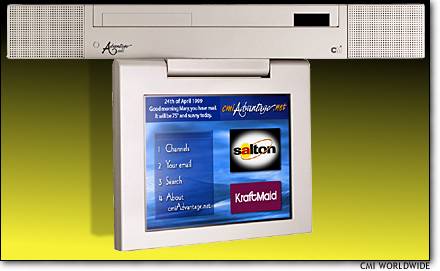 |
This is what CMI Worldwide's Advantage 2000 Kitchen PC should
look like when it's released later this year. This version has a flip-down flat-screen
monitor and fits under a kitchen counter. |
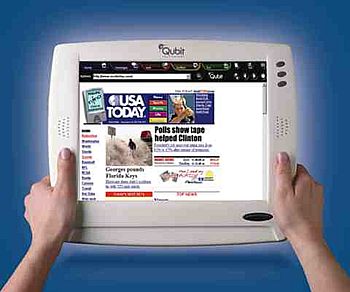 |
Qubit delivers the full, rich experience
of Internet exploration and electronic communication with none of the technical or
convenience barriers associated with personal computers. With Qubit any type of embedded
portal or browser like America Online and @Home can be accessed, including Java-based
applets, along with basic applications such as e-mail and address/phone books. The Qubit
has no moving parts, full multimedia capacity, and a touch-controlled, high-resolution
color tablet.
Installation is remarkably simple. Just plug Qubit’s cradle into an outlet and a
phone or cable jack. Everything else is handled automatically through interaction with a
remote service provider/content aggregator. Qubit is already configured to handle all
types of Internet connections, including 56K, DSL, and cable modems.
Roughly the size and shape of a magazine, Qubit represents the last word in physical
freedom for Internet users at home. Its wireless capability lets people go online anywhere
in the house and operate in complete comfort. For applications that require typing, a
wireless keyboard with a remote infrared link is provided. |
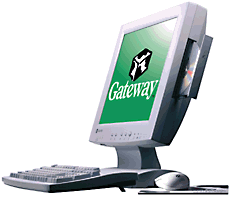 |
"Gateway Profile offers a complete
PC solution including an integrated LCD display. The entire unit takes up just over a
quarter of the space of your average desktop PC, making it ideal for the space conscious
client. Beyond that, it’s sleek and stylish – it makes an immediate
impression."
The Gateway Profile provides high end specs for use in both home and business environments
and features a 400MHz AMD K6-2 processor, a 15.1" LCD display, 64MB of main memory
(expandable to 256MB), 4.3 GB hard drive and 56k V.90 data/FAX modem as standard. It
includes a DVD-ROM drive (x2 speed, x20 speed used as CD-ROM drive) and a hardware MPEG
decoder which enables DVD-movie and other applications. It also features a 10/100 Mbps
Ethernet controller for easy network connection. |
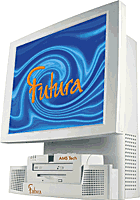 |
Using only one third the desk space of a
traditional desktop PC, it has all the horsepower and cutting edge features for your most
demanding applications.
Easy on your eyes, the Futura emits zero radiation with its 15" flat panel display,
giving you a viewable area comparable to a 17" monitor and you can swivel it for
landscape or portrait orientation.
Whether at home or in the office, anywhere space is at a premium, the elegant and sleek
Futura is the perfect solution for the most discerning computing users. |
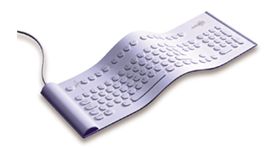 |
The SMART office and
industrial keyboards are a revolution to modern day keyboard thinking. With our
technology, it is now possible for your keyboard to be dropped on the floor, rolled up
into a 60mm tube and even washed or disinfected! |

|
Cyrix's WebPad is a great idea: This
3-pound, 8.5x11x1.75-inch (HWD), battery-powered tablet contains a Web browser and a
12-inch color touch screen. It comes with a stylus and a transceiver that allows it to
communicate with a base station. The base station, in turn, is attached to a modem, ISDN,
xDSL, or Ethernet line. The two communicate over a 2.4-GHz RF signal similar to the latest
portable phones. The WebPad is powered
by a Cyrix MediaGXT processor, and Cyrix expects that it will run NX, Windows CE, or an
embedded version of Windows NT.
Cyrix also expects to offer an external keyboard and
mouse connection via a pair of built-in USB ports. That will make answering email much
easier than using the stylus and hunting and pecking on the onscreen display. We were
impressed by the system-- even the early beta unit we were using. Unfortunately, Cyrix's
new WebPad isn't a real product yet. Cyrix expects OEMs to start shipping sometime in the
first half of 1999.
Available in many
colors to suit the individual user. |
 |
British Telecom (BT). SmartQuill is a space age
fountain pen sized handheld computer that can "read" hand written words. It
could start the biggest revolution in handwriting since the invention of the pen. Unlike conventional handheld computers, SmartQuill has no keyboard.
By harnessing the earth’s gravity, it uses an innovative spatial sensing system to
translate handwriting into typed text as it is being composed. Connecting to a PC,
printer, mobile phone, or modem is as simple as slotting the pen into a special
"inkwell."
SmartQuill can function as a diary, calendar,
contacts database, alarm, note taker, and calculator and can receive emails and pager
messages. When fully developed, it could put access to state-of-the-art communications
technology literally at your fingertips.
The pen can read handwriting not only on paper, but
on any flat surface - horizontal or vertical - and can even translate invisible writing in
the air. It recognises its owner’s signature as a password before it can be used. A
tiny light in the tip allows writing in the dark.
Handwriting recognition is achieved through
accelerometers that monitor hand movements. These accelerometers can also be used as a
"virtual hinge"to scroll around the small screen on the pen and to detect left
or right handed use. |
|